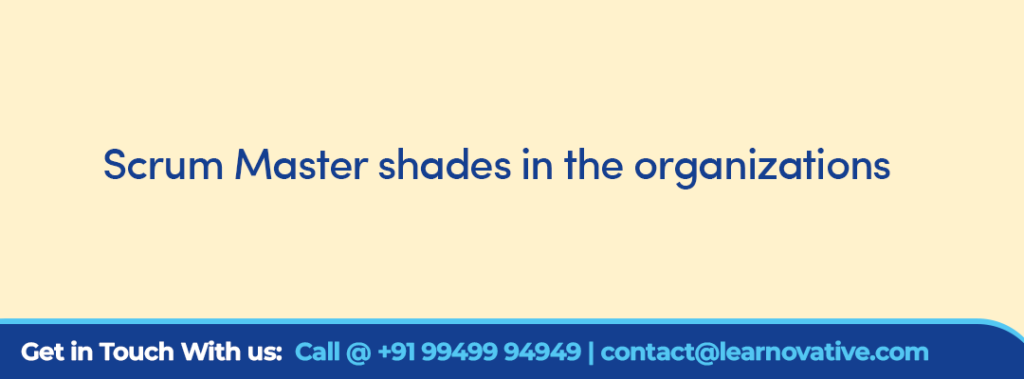
Many organizations are trying Scrum implementation as part of their Agile transformation. However, the implementation varies across different organizations. It is fine to have these variations as long as the core fundamentals of Scrum are not turned into extreme customizations (anti-patterns) in which case the results will be suboptimal.
In this article, we will discuss how the Scrum Master role is being showcased in organizations. We will see each type along with possible reasons, advantages and disadvantages in detail.
Dedicated Scrum Master: In this case the Scrum Master works with one team and supports them to become self-organized, cross-functional, coach, facilitate, and remove Global/systemic impediments for that team. This is the ideal case scenario and provides effective results.
Advantages:
- Team and Scrum Master will have great rapport
- Scrum Master can focus on team’s needs with undivided attention and commitment
Disadvantages:
- After certain duration, Scrum Master may not have much challenging learning
- Scrum Master may not be occupied much with work
Shared Scrum Master: In this case, a Scrum Master works with more than one team. Perhaps two to three teams will be supported by one Scrum Master. Results of this implementation will depend on the team’s maturity level. If the team is highly matured, self-organized, they may not need the Scrum Master all the time, but if the team is in the “forming” or “norming” stages of the “Tuckman” model, this may lead to suboptimal results.
Advantages:
- Multiple teams will be supported by one Scrum Master
- Scrum Master will have wider learning from different teams
- Organizations may witness cost saving
Disadvantages:
- If all teams need the Scrum Master at the same time for some critical impediments, then availability of Scrum Master will become problem
- Teams may go for wrong practices during their day to day work that might lead to wrong Scrum practices and they may not be recognized because of the Shared Scrum Master role
- Scrum Masters’ accountability may be diluted and he/she may not have same level of commitment due to switching across multiple teams
Rotational Scrum Master: In this approach, teams will have Scrum Master on demand basis from a pool of Scrum Masters. Every Sprint may have a different Scrum Master. In this approach, organizations do not have proper understanding of the Scrum Master role, they treat the Scrum master role as a “filler” role.
Advantages:
- More teams can be supported by less Scrum Masters
Disadvantages:
- Low trust between the Team and Scrum Master (just imagine if a Sports team will have a new coach for every game session!)
- Low trust leads to poor transparency
- Scrum Master will not have commitment for the team’s success
Manager turned into Scrum Master: As part of the Agile transformation, organizations try to force-fit existing people into the Scrum roles. One such practice is to convert existing project managers into Scrum Master role with an assumption that there is no difference between these roles. Fundamental understanding gap here is, treating Scrum Master as a “people manager” role, but it is not. This is a danger practice and should be avoided.
Advantages:
- It may help to keep existing people and move them into Scrum roles
Disadvantages:
- Teams experience command and control environment
- Teams will not become self-organized
- Teams cannot take up experiments
- Creates low trust and transparency within the team
Developer cum Scrum Master: In this implementation, one of the Development Team members will also play the Scrum Master role. He/she takes care of the product development function such as coding, testing, as well as Scrum Master responsibilities.
Advantages:
- Team can get Technical advices from the Scrum Master
- Technical impediments can be resolved quickly because Scrum Master is also a Developer/Tester
- Scrum Master also contributes to the Development so more work may be done by the team
Disadvantages:
- Team may be more dependant on the Scrum Master because of his/her technical skills, which may lead to low self-organization
- Same person playing both roles may lead to accountability issues
- While facilitating, Scrum Master may not be truly neutral
- The “Developer” mind may override the “Scrum Master”
- Coaching one’s self is difficult
- Servant leadership may be compromised
Product Owner cum Scrum Master: In this model, same person plays the Product Owner and also Scrum Master roles. The reason for this implementation is, organization leadership thinks that the Scrum Master role is like a sixth finger and not much important so the Product owner can take up the Scrum Master role also as an additional responsibility. Must avoid this implementation as it will lead to disastrous results.
Advantages:
- It may give a feeling that cost saving is possible to the management
Disadvantages:
- Leads to conflicts frequently due to role differences
- May give importance to one of the two roles and ignore the other
- Team may not be open to discuss Product Owner role’s issues with Scrum Master because both roles are played by same person
- Same person cannot focus on both Product and People at a time
Conclusion:
Quoting the “End note” of Scrum Guide: “Scrum’s roles, events, artifacts, and rules are immutable and although implementing only parts of Scrum is possible, the result is not Scrum. Scrum exists only in its entirety and functions well as a container for other techniques, methodologies, and practices.”. We do not find any Sports team in this world without a Coach. There is a need for someone to observe the team and help them to become better by optimizing processes, collaboration, communication, tools, techniques.
It is the “Scrum” it makes to work, and it is the team that “does” the work but you do need a Scrum Master. How you keep this role in the organization will decide the results, to be effective or suboptimal.
Recent Posts
- Essential Metrics to Measure Scrum Team Performance 17/04/2024
- How to influence without Authority? 17/04/2024
- Impact Mapping Example 08/04/2024
- Business Agility Vs Organizational Agility Vs Enterprise Agility 08/04/2024
- Agile Vs agile vs Agility 28/03/2024

